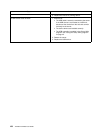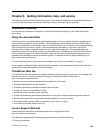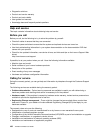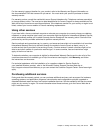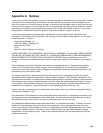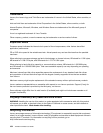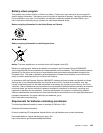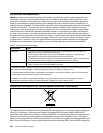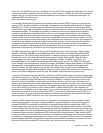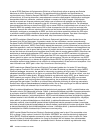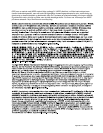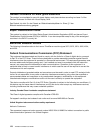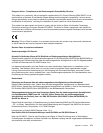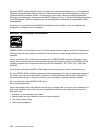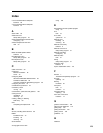
Particulate contamination
Attention: Airborne particulates (including metal akes or particles) and reactive gases acting alone or in
combination with other environmental factors such as humidity or temperature might pose a risk to the
server that is described in this document. Risks that are posed by the presence of excessive particulate
levels or concentrations of harmful gases include damage that might cause the server to malfunction or
cease functioning altogether. This specication sets forth limits for particulates and gases that are intended
to avoid such damage. The limits must not be viewed or used as denitive limits, because numerous
other factors, such as temperature or moisture content of the air, can inuence the impact of particulates
or environmental corrosives and gaseous contaminant transfer. In the absence of specic limits that are
set forth in this document, you must implement practices that maintain particulate and gas levels that are
consistent with the protection of human health and safety. If Lenovo determines that the levels of particulates
or gases in your environment have caused damage to the server, Lenovo may condition provision of repair
or replacement of servers or parts on implementation of appropriate remedial measures to mitigate such
environmental contamination. Implementation of such remedial measures is a customer responsibility.
Table 6. Limits for particulates and gases
Contaminant Limits
Particulate
• The room air must be continuously ltered with 40% atmospheric dust spot efciency
(MERV 9) according to ASHRAE Standard 52.2
1
.
• Air that enters a data center must be ltered to 99.97% efciency or greater, using
high-efciency particulate air (HEPA) lters that meet MIL-STD-282.
• The deliquescent relative humidity of the particulate contamination must be more than 60%
2
.
• The room must be free of conductive contamination such as zinc whiskers.
Gaseous • Copper: Class G1 as per ANSI/ISA 71.04-1985
3
• Silver: Corrosion rate of less than 300 Å in 30 days
1
ASHRAE 52.2-2008 - Method of Testing General Ventilation Air-Cleaning Devices for Removal Efciency by Particle
Size. Atlanta: American Society of Heating, Refrigerating and Air-Conditioning Engineers, Inc.
2
The deliquescent relative humidity of particulate contamination is the relative humidity at which the dust absorbs
enough water to become wet and promote ionic conduction.
3
ANSI/ISA-71.04-1985. Environmental conditions for process measurement and control systems: Airborne
contaminants. Instrument Society of America, Research Triangle Park, North Carolina, U.S.A.
Important information for the European Directive 2002/96/EC
The Waste Electrical and Electronic Equipment (WEEE) mark applies only to countries within the European
Union (EU) and Norway. Appliances are labeled in accordance with European Directive 2002/96/EC
concerning waste electrical and electronic equipment (WEEE). The Directive determines the framework for
the return and recycling of used appliances as applicable throughout the European Union. This label is
applied to various products to indicate that the product is not to be thrown away, but rather reclaimed upon
end of life per this Directive. Users of electrical and electronic equipment (EEE) with the WEEE marking per
166 ThinkServer RD330 User Guide



